NASA
 Seal | |
 | |
 Flag | |
| Agency overview | |
|---|---|
| Formed | July 29, 1958 |
| Preceding agency | |
| Jurisdiction | US Federal Government |
| Headquarters | Two Independence Square, Washington, D.C., United States 38°52′59″N 77°0′59″W / 38.88306°N 77.01639°W |
| Motto | For the Benefit of All[2] |
| Employees | 17,219 (2019)[3] |
| Annual budget | |
| Agency executives |
|
| Website | NASA.gov |
The National Aeronautics and Space Administration (NASA) is an independent agency of the United States Federal Government that deals with space exploration and aeronautics, the operating and designing of planes.[note 1] NASA has had many successful missions, for example the ISS, and Apollo 11, which put the first man on the Moon in 1969. NASA was founded on July 29, 1958.[7] NASA's motto is: "For the Benefit of All".[2] Since April of 2021, Bill Nelson, former Senator from Florida, has served as NASA Administrator.
Founding and the Sputnik crisis[change | change source]
NASA was preceded by the "National Advisory Committee for Aeronautics" (NACA). NACA was a US federal agency founded on March 3, 1915 to undertake, promote, and institutionalize aeronautical research. On October 1, 1958 the agency was dissolved, and its assets and personnel transferred to the newly created National Aeronautics and Space Administration (NASA).[8] NASA was founded to compete with the Soviet Union in the space race. In the 1950s and 1960s there was a space race between the US and the Soviet Union - now called Russia. The Soviets started first launching Sputnik 1, the first object made by people to go into orbit, in October 1957. The Americans were worried by this. It caused a crisis known as the Sputnik Crisis as the Americans feared the Russians might start building weapons in space. This all happened at a time called the Cold War when the US and the Soviet Union were always very close to war.
Space flight programs[change | change source]
Project Mercury (1958–1963)[change | change source]

Originally NASA was very small with only four laboratories and around eighty people working there. German engineers and scientists led by Wernher von Braun helped them build rockets. They had helped build the V-2 missile in Germany during World War II[9] and the Redstone missile for the US Army afterwards. Their Army missile laboratory was transferred to NASA.
In 1960 they set up the Mercury project. The Mercury Project space missions were designed by NASA, mostly to test if humans could survive in space. After they proved it was possible for people to live in space they moved on.
On May 15th 1961 astronaut Alan Shepard became the first American in space. Less than a year later, John Glenn became the first American to orbit or circle the Earth. He did so in a spacecraft called Friendship 7. Once the Mercury Project proved that humans could live in space, the Gemini Project was started. Less than a year after it began, the Apollo Program also began.
Project Gemini (1961–1966)[change | change source]

After the success of Mercury, NASA realized it had to start planning for its missions to the Moon. The Gemini spacecraft was built for two men. It was still small and cramped similar to the Mercury capsule, but allowed for more freedom of movement. Project Gemini proved that two spacecraft could rendezvous (meet and dock) in space. Neil Armstrong, the first man on the Moon, was also on the first Gemini flight to dock with another spacecraft in outer space. The Gemini spacecraft did not dock with another spacecraft with people in it. Instead, it docked with a rocket called "Agena target vehicle". The last few Gemini missions were science experiments and spacewalks designed to prepare for the Apollo Program, which would land human beings on the Moon.
Apollo program (1961–1972)[change | change source]
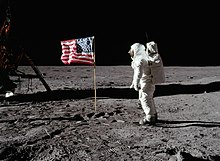
The Apollo program was started by President John F Kennedy in the 1960s. The program was made of 16 missions designed to send a man to the Moon and return him safely back to Earth. The first Apollo mission, Apollo 1, ended in disaster when a fire in the command module killed all the astronauts on board.[10] The Apollo 8 and 10 missions went to the moon. They tested equipment and took photos but did not land.
The project's main success came in 1969 when Neil Armstrong and Buzz Aldrin landed on the Moon as part of Apollo 11. The mission was a big success for NASA and over six million people watched it worldwide.[11] After Apollo 11, six more Apollo flights went to the moon. Five of them landed. The one that did not land, Apollo 13, had to abort its mission when an oxygen tank exploded in the spaceship. Apollo 17 was the last mission to land on the Moon.
Skylab (1965–1979)[change | change source]

After Congress stopped the Moon landings, NASA needed a new direction. Using a leftover Saturn V rocket, the giant rocket that sent men to the Moon, they created a space station that orbited above the Earth. This space station was called Skylab. Skylab was very big on the inside, even bigger than a small house. Skylab was visited by Apollo spacecrafts. There were three missions to Skylab. Each of them carried important experiments. The last crewed mission, Skylab 4, spent 84 days, 1 hour, 15 minutes, 30 seconds, longer than any space mission had spent until 1977. Skylab broke up in the atmosphere in 1979.
Apollo–Soyuz Test Project (1972–1975)[change | change source]
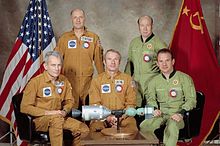
During the Space Race, the Soviets had designed their own spacecraft to fly to the Moon. Their spacecraft was called Soyuz. The Soviets never landed on the Moon, they had too many problems.[12] Instead, they started creating small space stations. The Soyuz spacecraft is what they used to go to these space stations. US and Soviet Union were part of the Cold War. In order to make peace between Soviet Union and US, they decided they would dock an Apollo spacecraft to a Soyuz spacecraft in space. After docking, the crews performed experiments and learned about each other's cultures. Apollo–Soyuz was the last flight of the Apollo spacecraft. It has never been used since, and as of 2020, there are no plans for it to be used again.
Space Shuttle program (1972–2011)[change | change source]
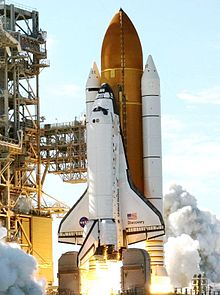
In the 1980s and 1990s NASA began to concentrate on building Space Shuttles. Four Shuttles were built in 1985. The first to launch was the Space Shuttle Columbia on April 12, 1981. At this time the public began to lose interest in the space program and NASA faced budget cuts. They had planned for the Space Shuttles to cost less as they could be used more than once. But eventually it turned out the Space Shuttles were more expensive as building them in the first place cost more money than normal. There were further problems for NASA after the Space Shuttle Challenger disintegrated in flight in 1986, killing all seven of its astronauts. The incident is known as the Challenger Disaster.
The Challenger Disaster forced NASA to think about the way they worked. The entire Space Shuttle fleet was suspended for a year.[13] After that, NASA launched the Hubble Space Telescope into orbit. Its most famous photo was the Hubble Deep Field.[14]
In 2011, NASA shut down the Space Shuttle program. They were more expensive to use than other launch vehicles.
International Space Station (1993–present)[change | change source]

In the early 1980s, NASA planned Space Station Freedom as a counterpart to the Soviet Salyut and Mir space stations. It never left the drawing board and, with the end of the Soviet Union and the Cold War, it was cancelled. The end of the Space Race prompted the U.S. administration officials to start negotiations with international partners Europe, Russia, Japan and Canada in the early 1990s in order to build the International Space Station. This project was first announced in 1993 and was called Space Station Alpha.[15] It was planned to combine the proposed space stations of all participating space agencies: NASA's Space Station Freedom, Russia's Mir-2 (the successor to the Mir Space Station, the core of which is now Zvezda) and ESA's Columbus that was planned to be a stand-alone spacelab.
Curiosity rover (2011–present)[change | change source]
Curiosity is a car-sized rover. It was made to explore the crater Gale on Mars. Curiosity was launched from Cape Canaveral on November 26, 2011, at 15:02 UTC and landed on Aeolis Palus inside Gale on Mars on August 6, 2012, 05:17 UTC. The Bradbury Landing site was less than 2.4 kilometres (1.5 miles) from where the rover landed after a 560 million kilometres (350 million miles) journey. The goals of the rover include an investigation of the Martian climate and geology.
Artemis program[change | change source]
Artemis 1 was a flight that landed in December 2022. The flight was to test the Orion Space Capsule for Artemis missions in the future. (See Orion (spacecraft).) Artemis missions are later supposed to have astronauts.
Peregrine Mission One[change | change source]
Peregrine Mission One was launched in January 2024.
NASA's future[change | change source]

- The Artemis 2 mission, is scheduled to launch in 2025's third quarter. The spaceship is supposed to do a flyby of the Moon. The choice of astronauts (as of 2024's second quarter)
- Artemis 3, it is supposed to land a crew on the Moon. The mission depends on a support mission to put a Starship Human Landing System (HLS) in place in a near-rectilinear halo orbit of the Moon. The SLS with Orion (spacecraft) will be part of Artemis 3.
- Artemis 4, it is supposed to land a crew on the Moon, no earlier than September 2028.
- Artemis 5, it is supposed to land a crew on the Moon, no earlier than September 2029. "Blue Origin [...] was chosen [... in 2023] to develop the landing system for Artemis" 5.[17]
In early 2010, President Barack Obama cancelled the Constellation project that was aiming to have humans return to the moon's surface by 2020.[18] He said the project was "behind schedule and lacking in innovation".[18] At the same time he cut back the amount of money NASA will be getting from the government in 2011.[19]
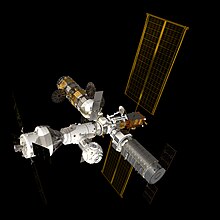
When President Barack Obama did this, he also worked with NASA to create the Space Launch System. This, with commercial launch vehicles (launch vehicles that are not owned by NASA), will take humans to the Moon, Mars and Ceres.[20][21]
In 2069, NASA plans to send a space probe to Alpha Centauri, the closest star system to the Sun. The proposed launch would be on the 100th anniversary of the first Moon landing, Apollo 11.[1]
NASA is continuing operations include missions to the planets Mars, Saturn and Pluto. Missions to Jupiter are also planned for the future.[22]
NASA Missions[change | change source]
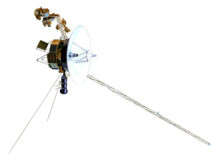
NASA has launched over 500 missions. Over 150 missions had humans on board. Such manned missions are the most expensive and make the most news but the majority of launches are for space exploration, science, and other purposes that do not need people. NASA spacecraft such as Cassini-Huygens and the Voyager program have visited every planet in the Solar System. Four NASA spacecraft have left the Solar System, Voyager 1, Voyager 2, Pioneer 10 and Pioneer 11, while the fifth, a New Horizons spacecraft is estimated to exit the solar system by 2048. As of 2022 Voyager 1 is 23,447,000,000 (23.4 billion) kilometers away from Earth and Voyager 2 was at a distance 19,474,000,000 (19.4 billion) kilometres away from Earth.[23]
The New Horizons spacecraft flew past Jupiter in February 2007, studying some of the planet's moons. On July 14, 2015 the craft flew by Pluto, took high resolution pictures of the planet's surface and analysed the chemical properties of its atmosphere.
Use of the metric system[change | change source]
Like other scientific organizations, NASA conducts most of its measurements in the international system (metric system). This is partially due to federal law requiring that most US government programs be done in the international system. In the 1980s, NASA transitioned to the metric system, but was still using US customary \ imperial units into the 1990s. In September 1999, a mixup (or mistake) between imperial and metric units resulted in the loss of the Mars Climate Orbiter.
Related pages[change | change source]
- Administrators and Deputy Administrators of NASA
- Cape Canaveral Air Force Station
- Kennedy Space Center
Notes[change | change source]
- ↑ NASA is an independent agency that is not a part of any executive department. However, it reports directly to the President.[5][6]
References[change | change source]
- ↑ US Centennial of Flight Commission, NACA Archived February 20, 2014, at the Wayback Machine. centennialofflight.net. Retrieved on November 3, 2011.
- ↑ 2.0 2.1 Lale Tayla & Figen Bingul (2007). "NASA stands 'for the benefit of all.'—Interview with NASA's Dr. Süleyman Gokoglu". The Light Millennium. Archived from the original on October 12, 2007. Retrieved September 17, 2018.
- ↑ "Workforce Profile". NASA. Archived from the original on February 14, 2013. Retrieved April 23, 2018.
- ↑ Casey Dreier (February 15, 2019). "NASA just got its best budget in a decade". The Planetary Society. Archived from the original on February 16, 2019. Retrieved February 15, 2019.
- ↑ "Official US Executive Branch Web Sites – Newspaper and Current Periodical Reading Room (Serial and Government Publications Division, Library of Congress)". loc.gov. Retrieved May 24, 2016.
- ↑ "Frequently Asked Questions". hq.nasa.gov. Archived from the original on May 4, 2016. Retrieved May 24, 2016.
- ↑ "The National Aeronautics and Space Act". NASA. 2005. Retrieved 2008-07-10.
- ↑ Erickson, Mark (2005). Into the Unknown Together - The DOD, NASA, and Early Spaceflight (PDF). ISBN 978-1-58566-140-4. Archived from the original (PDF) on March 8, 2003.
- ↑ "Wernher von Braun in SS uniform". reformation.org. Archived from the original on 2019-09-23. Retrieved 2008-07-13.
- ↑ "Apollo 1 - A history of NASA". Retrieved 2008-07-14.
- ↑ "Publications of the Astronomical Society of Australia" (PDF). CSIRO. Retrieved 2008-07-13.
- ↑ "Soviet Lunar Landing". Encyclopaedia Astronautica. Retrieved 2019-05-18.
- ↑ "NASA Shuttle Fleet Grounded after Challenger explosion". wsws.org.
- ↑ "Hubble Deep Field - The most important image ever taken?". Deep Astronomy. Archived from the original on 2008-04-10.
- ↑ GAO (June 1994). "Space Station: Impact of the Expanded Russian Role on Funding and Research" (PDF). GAO. Retrieved 2006-11-03.
- ↑ https://www.nrk.no/urix/disse-fire-skal-til-manen-1.16362623. NRK.no. Retrieved 2023-04-03
- ↑ https://www.proactiveinvestors.com/companies/news/1015588/blue-origin-scores-3-4b-nasa-contract-for-artemis-v-moon-landing-1015588.html. Retrieved 2023-05-19
- ↑ 18.0 18.1 "Obama cancels space program". BBC News. Retrieved 2010-02-06.
- ↑ "Slashed NASA budget leaves the US no longer a space leader". Chron.com. 7 February 2010.
- ↑ Stephen Creech (April 2014). "NASA's Space Launch System: A Capability for Deep Space Exploration" (PDF). NASA. Archived from the original (PDF) on 2016-03-07. Retrieved 2019-03-07.
- ↑ "Moon to Mars | NASA". 25 June 2018. Archived from the original on 2019-05-22. Retrieved 2019-05-23.
- ↑ "BBC Mission guide: New Horizons". BBC. Retrieved 2008-07-14.
- ↑ Spaceflight, Mike Wall 2013-09-13T09:09:40Z (13 September 2013). "Interstellar Traveler: NASA's Voyager 1 Probe On 40,000-Year Trek to Distant Star". Space.com. Retrieved 2019-03-07.
{{cite web}}: CS1 maint: numeric names: authors list (link)
Other websites[change | change source]
- NASA.gov - official website
- NASA Television
- NASA Photos Archived 2010-11-12 at the Wayback Machine
- How NASA works
- NASA for Kids Archived 2021-04-17 at the Wayback Machine
- NASA Spaceflight news site
